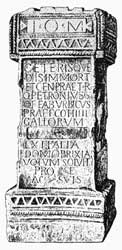
Click on the image for a larger version.
Image ownership:
© Vindolanda Trust |
|
| Text |
Translation |
|
I(ovi) O(ptimo) M(aximo)
ceterisque
diis immort(alibus)
et Gen(io) praetor(i)
Q(uintus) Petronius
Q(uinti) f(ilius) Fab(ia tribu) Urbicus
praef(ectus) coh(orits) IIII
Gallorum
. . . . . . . . .
ex Italia
domo Brixia
votum soluit
pro se
ac suis |
To
Jupiter Greatest and Best,
and to the other
immortal gods
and to the Genius of the praetorium
Quintus Petronius
Urbicus, son of Quintus, of the Fabian voting tribe,
prefect of the 4th cohort of Gauls
……..,
from Italy
from Brescia,
fulfilled his vow
on behalf of himself
and his family.
|
|
|
The structure of a person's name, as well as the choice of name
itself depended on a variety of factors, for example gender, social
status, and cultural background. The parts of a name used in different
contexts and documents also varies.
Citizens
The name of the Roman citizen consisted of three elements, often
referred to as the tria nomina: first a forename (praenomen),
such as Marcus, Lucius or Titus, often abbreviated (e.g. M., L.
T.); second a family name (gentilicium or nomen);
third an additional name or names (cognomen / cognomina).
The cognomen might be a nickname, or a name with local or regional
connections, for example a tribal name. The limited number of forenames,
and the tendency from the first century AD to give sons the same
name meant that the cognomen allowed individuals who shared
the same names to be distinguished. When non-citizens were made
citizens, they often took the names of the reigning emperor, a patron
or benefactor. This accounts for the frequency of Julius, Claudius
or Flavius among provincials in the early Roman empire.
Names can be a guide to family history. The nomen of Flavius
Cerialis is that of the Flavian dynasty, implying that Roman citizenship
was acquired by Cerialis or a forebear after AD 70, when the rule
of the first Flavian emperor, Vespasian, began. The cognomen,
Cerialis, is the same as that of Petillius Cerialis, the Roman general
who ended the Batavian revolt in AD 69/70 and who governed Britain
in the early 70s, recommencing the conquest of the north. Perhaps
Cerialis' father or Cerialis himself remained loyal to Rome during
the Batavian revolt and
was granted citizenship in return for loyalty, Petillius
Cerialis acting as his patron. Flavius was a common name among
the Vindolanda correspondents, other 'Flavians' including Flavius
Genialis and Flavius Conianus. Iulius Verecundus and Claudius Karus
took their names from the earlier
Julio-Claudian emperors. Other citizens whose names are documented
include the commanders of auxiliary units elsewhere, for example
Aelius Brocchus (233), perhaps the same person as a C. (Gaius) Aelius
Brocchus recorded on an inscription in Pannonia (Hungary), as well
as legionaries, for example Vittius Adiutor, a standard bearer of
Legio II Augusta (214).
Different parts of names were used in different contexts. In the
tablets, as in everyday practice, individuals addressed one another
by their nomen and cognomen. We do not therefore know
the praenomen of Flavius Cerialis. On formal documents, for
example inscriptions, the other parts of names were recorded. As
well as the nomen, these included filiation (the name of
one's father), voting tribe (all Roman citizens belonged to one
of these), and the place from which one came (origo), important
for proving citizenship. The altar set up between AD 222 and 235
by a later commandant of the Vindolanda garrison Quintus Petronius
Vrbicus provides an example of all the name elements (see above).
Auxiliary soldiers and non-citizens
Ordinary auxiliary soldiers did not generally receive citizenship
till after their discharge, although sometimes they adopted the
tria nomina before they were entitled to do so. Many individual
names in the Vindolanda tablets probably belong to auxiliary soldiers.
Personal names of the Roman empire drew on the languages and naming
traditions of the many peoples of the empire, in this case the area
of northern Gaul from which they came, but provincials also adopted
Roman names. In the western provinces for example, including at
Vindolanda, certain Roman names, for example Candidus (180)
or Verecundus (210)
became popular, sometimes making it difficult to identify the origin
of the person in question.
Women
Women did not have a praenomen, but took the feminine form
of their father's family name (nomen / gentilicium) and sometimes
the feminine form of his cognomen. The two best documented women
at Vindolanda, Sulpicia Lepidina, wife of Cerialis, and her friend
Claudia Severa therefore came from the families of the Sulpicii
and Claudii respectively (291).
The family name Sulpicia may suggest that Lepidina or one of her
forebears was granted citizenship during the brief reign of emperor
Sulpicius Galba (AD 68-69). On marriage women kept these names and
added that of their husband in the genitive, e.g. 'of Marcus'.
Slaves
Slaves had a single name, given when bought or at birth, followed
by the name of the master in the genitive, 'the slave of …..',
sometimes followed by servus 'Candidus the slave of Genialis'
(Candidus Genialis praefecti), or 'Rhenus the slave of Similis'
(Rhenus Similis servus) If freed they usually took the
praenomen and nomen of their former master. Greek
names may indicate servile status, especially in provinces like
Britain, outside the areas in which there was a large resident Greek
population. Some Greek names recorded in the Vindolanda tablets
might be those of slaves but might also be names of soldiers (311).
For further information see people of Vindolanda in the exhibition.
|